#Dun Aengus
Explore tagged Tumblr posts
Text
21/08/2015








これからイニシュモア島へ🚢
とにかく酔う!と定評のある船です(苦笑)。噂通り、外海に出た途端に縦揺れ横揺れが激しすぎます…。衰弱して船の中でぐったり。 私の相席はイタリア人グループの添乗員さんで、ずっとPC入力していました。年配の男性ですが、何でこんなにスーツの着こなしがカッコいいんだろうと思ってしまいました。
そして不謹慎な話ですが、 私「今何時ですか?」 イタリア人「eleven hour」 私「は?」 11時間ですか…? ほらほらって腕時計を見せてくれたのはちょうど午前11時。
帰国後に知りましたが、イタリア語は時計・時刻絡みの用語が1つでまとまっているらしく、「time」「hour」「o'clock」など使い分けが苦手傾向にあるそうです。 アイルランドの公用語はアイルランド語と英語なので、私がBroken Englishを話しても向こうが言いたいことを察してくれるという大変有り難い国でもあります。そして、イタリア人添乗員さんが堂々と間違えた英語を使っても、通じてしまうのを思うと私も堂々と間違えて英語を使っていいんだと根拠の無い自信がついた瞬間でもありました笑

���ニシュモア島に上陸です!

海老のカクテルサラダ🦐











Dun Aengus
大西洋の外に向かう強風にあおられて、毎年観光客の死者が絶えないという、噂の場所です。 日本人観光客も毎��1人落ちて亡くなっているそうです。最近はどうなんでしょうか…?

自己責任・匍匐前進で命懸けの記念撮影です。



帰りの船を待っていると「コンニチハ」口撃で、ミラノから来たというイケメンくんにナンパされました。 アイルランドなんてアジア人は来ないエリアに日本人がいたから声をかけたそうです。 因みに彼は『日本人・韓国人・中国人の区別はつく』と言っていました笑 そんなイケメンナンパくんは美人の彼女と同伴。ふと彼女の顔を見たら鬼の形相でこちらを見るではありませんか👹 彼女の機嫌がよくなったのは帰りの船が別ということが分かり、別れる瞬間でした…(苦笑)
#備忘録#photography#reminder#Ireland#Dun Aengus#Aran Islands#oileáin Árann#Dún Aonghasa#Aranmore#Árainn Mhór#風と石の国#Galway#コンニチハ口撃#ミラノから来たイケメンナンパくん
0 notes
Text
#OTD in Irish History | 6 January:
In the Liturgical Calendar, today is Epiphany and Little Christmas (Nollaig Bheag) and/or Women’s Christmas (Nollaig na mBan) and/or Twelfth Day (the traditional end of the Christmas season) and for Irish Roman Catholics, a Holy Day of Obligation. 1562 – Shane O’Neill submits to Queen Elizabeth at Whitehall, but rebels again within months. 1654 – Commissioners are appointed to allot the land of…

View On WordPress
#irelandinspires#irishhistory#OTD#6 January#Cliffs at Dun Aengus#Co. Galway#History#History of Ireland#Inishmore#Ireland#Irish Civil War#Irish History#Irish War of Independence#Today in Irish History
10 notes
·
View notes
Text
Tochmarc Étaíne
Tochmarc Étaíne ('The Wooing of Étaín')is a story from the Irish Mythological Cycle. The two main sources for the text is the Lebor na hUidre ('Book of the Dun Cow'), which dates as far back as 1106 and the Yellow Book of Lecan, from circa 1401. The full text can be split into 3 sections which tell the story of Étaín. It's very confusing for me, who knows little of Celtic or Irish mythology, because it features characters who are famous from other myths, but I'll do my best to summarize it.
It's a tale of accidental incest between a father and his daughter, in which they are tricked into sleeping together by the magical race of the Tuatha Dé Danann.
I'll be using the translation by Jeffrey Gantz in the book Early Irish Myths and Sagas from 1981.
The story starts with the birth of Oengus (also known as Aengus) who honestly doesn't concerns us very much. The only important thing about him is that he has to win Étaín's hand from her father Ailill. Not for himself, mind you, but for his foster-father Mider. For a year Étaín and Mider live together in Oengus's lands, but eventually comes the time for them to return to Mider's own lands. Once they arrive, Mider's first wife, Fúamnach, becomes enraged that has husband has remarried and lived away from her for a full year and transforms Étaín in a pool of water. After the water evaporates, a giant scarlet fly appears in it's place. All this people are Tuatha Dé Danann, which are kinda of gods or maybe sidhe (fairies), I'm not really sure.
Mider recognizes the fly as being Étaín and travels with it, never taking another wife. Fúamnach is not yet pleased with this and conjures a storm to blow Étaín away. For seven years she drifts in the wind, before finally landing at Oengus' castle, where he takes care of her. Fúamnach is still having none of it and once again conjures a storm to carry Étaín away. For another seven years she is dragged by the wind, until she lands in the of Étar's wife. The woman swallows the fly and becomes pregnant with Étaín. Born again, Étaín is re-raised by Étar.
Echu (or Eochu) Airem is the High King of Ireland and he seeks a wife. He chooses Étaín, for she's the most beautiful woman of all. However, Echo Airem has a brother, Ailill Angubae (no relation to Étaín's father Ailill), who also falls in love with Étaín. His love for Étaín is so great that he falls ill for not being able to consummate it. While Angubae is in his deathbed, Airem goes on trip, leaving Étaín alone with his brother. Angubae confesses his feelings, which Étaín reciprocates, and they agree to meet in the middle of the night in a hill. Three times she goes there, but instead of Angubae, she finds Mider. After the third time, Mider explains to her that he is her husband and that they had been kept apart by Fúamnach sorcery. She agrees to go with him, but only if Airem allows it.
Airem returns from his trip and is visited my Mider, who challenges him a game of fidchell, which seems to a board game. Day after day, the two play the game and the stakes keep rising, until Mider says that, if he wins, he wants a kiss and a embrace from Étaín. Mider wins and takes his prize, hugging Étaín and causing the two transform into swans, now able fly away from Airem.
Airem isn't happy with this and has this servants search for Étaín in every síd (a fairy-mound, where the Tuatha Dé Danann live) in Ireland. They find Mider, who agrees to let Airem take back Étaín if he can identify her among fifty woman. Airem picks the woman he believes to be Étaín.
Time passes and Mider comes to visit once again and reveals the truth: the real Étaín is with him and Airem has his own daughter.
"Your wife was pregnant when I took her from you, and she bore a daughter, and it is that daughter who is with you now. Your wife is with me, and you have let her go a second time."
The 1147 book called An Banshenchas, which is basically a list of important woman in folklore, named this daughter as Esa.
"Etain was wife of Eochu Aireman. Esa was her daughter, evil were her rites. Her name is given to a lofty spot, allied by her crimes to pollution. Mes Buachalla was Esa's daughter."
The phase "evil were her rites", which accompanies Esa, is a reference to the incestuous union with her father. Although I would hardly call it "evil" especially because we have no idea if Esa even knew who Airem was. Maybe she was raised believing herself to be Mider''s daughter.
Airem becomes disgusted that he slept with his own daughter and, more over, has gotten Esa pregnant.
"He was distressed that his wife had escaped and that he had slept with his own daughter: his daughter, moreover, became pregnant and bore a daughter."
Trying to hide this, Airem has the child of the incestuous union taken away to be eaten by wolves, but she is found and raised by Findlám, a herdsman. This child grows up and is eventually married to the new High King, Eterscélae (he replaced Airem on the throne, but it's not a dynasty thing, he's not related to Airem at all). This marriage results in the birth of Conare (or Conaire), about whom many other legends were written.
The Conare legends, the Togail Bruidne Dá Derga, name his mom Mess Búachalla, daughter of Étaín and Echu Feidlech, Airem's other brother. Like most ancient stories, there are simple too many inconsistentes because they were told and retold many times. However, I'll summarize as: Étaín and Airem birth Esa. Esa and Airem incestuous union result in the birth Mess Búachalla. Mess Búachalla and Eterscélae birth Conare.
I wish we knew what happened with Airem and Esa. The story doesn't mentions their fates, or Étaín's and Midir. Maybe other texts does. Either way, this story can let us glimpse at what the ancient Irish thought of incest, since Airem is so ashamed of what he did that he leaves the proof of the union to die. Not only that, but the incest is framed as a punishment by Mider for Airem's destruction of the síds.
It kinda has Oedipus Rex vibes to it, the acidental incest resulting in tragedy and all that. Which reminds me I've never covered Oedipus... maybe I should
6 notes
·
View notes
Text
Irlanda: Isole Aran - Inishmore
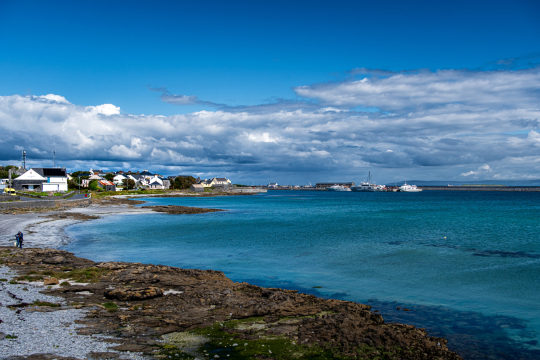
Le Isole Aran sono un gruppo di tre isole situate al largo della costa occidentale dell'Irlanda. Queste isole, Inishmore, Inishmaan e Inisheer, sono famose per la loro bellezza naturale, la ricca storia e la cultura unica che le rende una destinazione turistica popolare per i visitatori di tutto il mondo.

Una delle caratteristiche più distintive delle Isole Aran è la presenza di antichi siti archeologici, come il Forte di Dun Aengus sull'isola di Inishmore. Altri siti di interesse includono il Forte di Dun Duchathair e il Forte di Dun Eochla, entrambi situati sull'isola di Inishmore.

Forte di Dun Aengus Il Forte di Dun Aengus è uno dei siti storici più suggestivi e affascinanti dell'Irlanda. Situato sull'isola di Inishmore, nella contea di Galway, questo antico forte preistorico risale a circa 1100 a.C. e rappresenta un importante esempio di architettura difensiva dell'età del ferro.

Il forte si trova su una scogliera a picco sul mare, offrendo una vista mozzafiato sull'oceano Atlantico. Le sue mura di pietra, costruite senza l'uso di malta, si ergono per circa 6 metri di altezza e circondano un'area interna di circa 50 metri di diametro. L'accesso al forte avviene attraverso un ingresso stretto e basso, che fungeva da punto di difesa contro eventuali attacchi nemici.
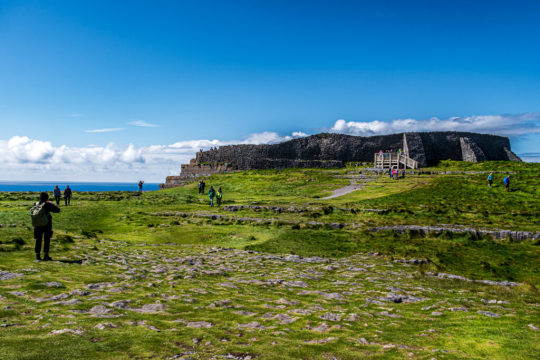
La struttura del forte è divisa in tre terrazze concentriche, ognuna con un proprio muro difensivo. La terrazza più esterna è stata probabilmente utilizzata come area di stoccaggio e allevamento di bestiame, mentre le terrazze interne ospitavano le abitazioni dei residenti e i luoghi di culto.
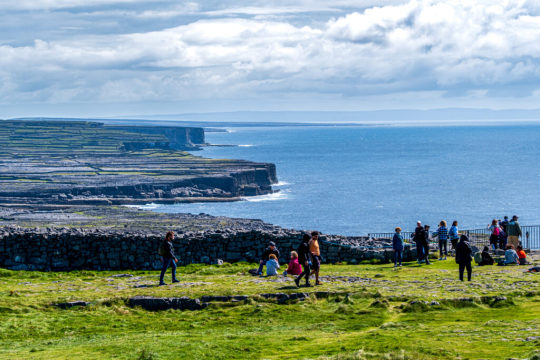
Il Forte di Dun Aengus è stato oggetto di numerosi studi archeologici che hanno permesso di scoprire reperti di grande valore storico, come manufatti in pietra e ossa di animali. Questi reperti testimoniano l'importanza del forte come centro di potere e controllo territoriale nell'antichità.

La visita al Forte di Dun Aengus è un'esperienza unica e indimenticabile, che permette ai visitatori di immergersi nella storia millenaria dell'Irlanda e di ammirare da vicino l'ingegnosità e la maestria dei suoi antichi abitanti. La suggestiva posizione del forte, unita alla sua imponente struttura e alla sua ricca storia, lo rende una tappa imperdibile per chiunque desideri esplorare le meraviglie dell'isola di Inishmore.

Tradizioni culturali Le Isole Aran sono anche conosciute per la loro cultura tradizionale, che è rimasta intatta nel corso dei secoli. La lingua gaelica è ancora parlata su queste isole e la musica tradizionale irlandese è una parte importante della vita quotidiana. I visitatori possono partecipare a sessioni di musica tradizionale nei pub locali e assistere a spettacoli di danza irlandese.

La natura selvaggia e incontaminata delle Isole Aran le rende un luogo ideale per gli amanti dell'outdoor. Gli escursionisti possono esplorare i sentieri panoramici che attraversano le isole, mentre gli appassionati di birdwatching possono avvistare una varietà di specie di uccelli, tra cui il famoso pappagallo di mare.
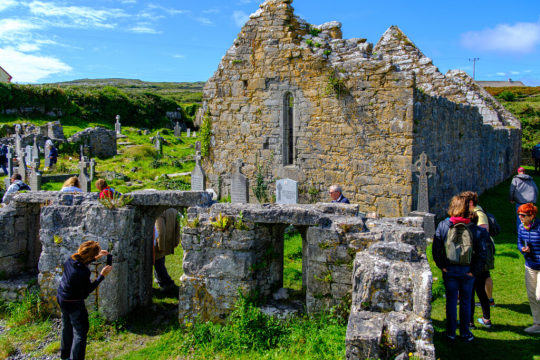
Per coloro che desiderano immergersi completamente nella cultura delle Isole Aran, è possibile soggiornare in uno dei caratteristici bed and breakfast gestiti da famiglie locali. Questi accoglienti alloggi offrono un'esperienza autentica e un'opportunità per interagire con gli abitanti del luogo.
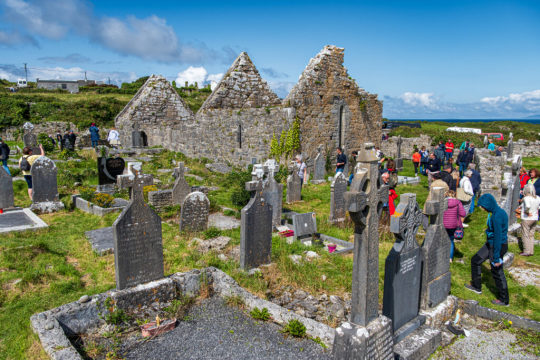
In conclusione, le Isole Aran offrono una combinazione unica di storia, cultura e natura che le rende una destinazione imperdibile per chiunque visiti l'Irlanda. Con le loro antiche rovine, la musica tradizionale e i paesaggi mozzafiato, queste isole incantate cattureranno sicuramente il cuore di chiunque abbia la fortuna di visitarle.

Read the full article
0 notes
Text
Day 9 and the fortress Dun Aengus…open to the ocean 300 ft below
There was no fence to show you how close to the edge you could go snd some people belly crawled to the edge to have a look. We did not … too scary!!










1 note
·
View note
Photo

As if suspended in ancient times
Dún Aonghasa, Inish Mór, June 2019
#photographers on tumblr#original photography#photography#ireland#inishmore#aran islands#dun aengus#county galway#ruins#fort#archeology#bronze age#stone walls#architecture#green#nature
56 notes
·
View notes
Text
Dun Aengus Hill fort
A webpage on Dun Aengus Hill fort
https://www.hillforts.co.uk/dunaengus
0 notes
Text
Aran Islands
Someone once observed that the world's historians owe a great debt for building an independent civilization and preserving it almost intact into modern times. Nowhere perhaps is that true than on the Aran Islands. Although a bit of tourism and television have brought the twentieth century creeping in, these three hunks of rock struck 30 miles out in the steely grey waters of the Atlantic off the coast of Galway remain a very much of another time, one of the last outposts of the real Irish culture. Gaelic for instance, remains the first – and for many islanders the only – language.
The three Islands – Inishmore, Inisheer, and Inishmaan – are home to about 2,000 people, though they have little more than 18 square miles of area between them. For scholars they are notable for their prehistoric monuments – the great stone complex of Dun Aengus on Inishmore is perhaps the finest prehistoric fort in Europe – but for many others the appeal lies in their bleak and elementary beauty. Few landscapes can have offered a more forbidding prospect to their early settlers or been more painstakingly conquered. The early Christian hermits who were the island's first inhabitants found a terrain not only treeless but soilless. The earth that today nurtures the island's animals and crops is entirely manmade, compounded of alternating layers of sand and seaweed and sustained by generations of patients. The only thing the Arans possess in abundance is rocks, which are everywhere piled in a dense network of sheltering, waist-high, dry stone walls, making the islands look from every vantage point like outsized jigsaw puzzles.
Of the three islands, only Inishmore has a harbour that can accommodate ferries. To reach the other two islands, the ferry heaves to as near the shore as it can and the islanders come out in curraghs – frail-looking canvas-covered boats – to bring ashore passengers and provisions. For anyone really trying to get away from it all, the two small islands are perhaps the more rewarding – not only for the excitement that coming ashore in one of the featherweight curraghs but also because there are fewer visitors. On the other hand, Inishmore has better attractions – and comforts.
No hotels exist on any of the islands, but Inishmore has a number of pleasant guesthouses, mostly clustered around the little harbour at Kilronan. There are also three pubs, a restaurant, a tearoom/fish and chip shop, and, invitably, a few souvenir shops, some of them selling quite good island handicrafts. You can be taken around the island on a pony and trap or you can rent bicycles for only about £2.50 at the harbor. Inishmore is a cyclist’s paradise thanks to the almost complete absence of traffic, the island's surprisingly mild climate, compact size, and wealth of dramatic vistas. The stone thought of Dun Aengus, perched on a sheer cliff 265 feet above the sea, provides a memorable destination, that's wherever you go a gratifying and prospect of hardy thatched cottages, abundant wildflowers, and steep descents to a crashing sea will confront you.
Details: There are daily air services throughout the year to all three Aran Islands (it's about a 20-minute flight from Galway), but most people cross by ferry from Galway. There are two calories a day and the trip takes about three hours.
William Bryson, The Palace Under the Alps, p150-151 https://www.aranislands.ie
4 notes
·
View notes
Text


Today I visited the 3,000 year old cliff top fort of Dun Aengus— while wearing my Tinker Bell shirt! ✨
8 notes
·
View notes
Text
Inis Mor, Aran Islands, Republic of Ireland
Inis Mor, Aran Islands, Republic of Ireland #aranislands #biketour #excerise #explore #ireland #travelblogger
Today we leave Galway to check out Inis Mor, the largest of the Aran Islands just off the coast. We had to walk 1.5 blocks from the hostel to catch the charter bus, everyone from Shamrocker Adventures and some other tour groups boarded the Aran Island buses. After a short trip along the coast we reached a marina where large sea ferries waited to take everyone over to the islands.






There are…
View On WordPress
#aengus#altantic#ancient#aonghasa#aran#background#blue#Busabout#cliff#coast#coastal#cycling#dun#europe#fabric#galway#grass#green#house#inis#inishmore#ireland#Irish#island#isle#landscape#natural#nature#needlework#outdoors
0 notes
Video
youtube
🔥 5.12.2016 - SEIDÄ PASS 🔥 Live @ Dun Aengus Rattenberg (Tirol / Austria...
10 notes
·
View notes
Text
Watch "🔥 5.12.2016 - SEIDÄ PASS 🔥 Live @ Dun Aengus Rattenberg (Tirol / Austria) - Perchten Hexentanz" on YouTube
youtube
1 note
·
View note
Text
#OTD in Irish History | 6 June:
#OTD in Irish History | 6 June:
In the Liturgical calendar, today is the Feast day of Saint Iarlaithe mac Loga, also known as Jarlath, first Abbot-Bishop of Tuam, an Irish priest and scholar from Connacht, remembered as the founder of the monastic School of Tuam and patron saint of the Archdiocese of Tuam. 1333 – William de Burgh, Earl of Ulster, ‘the Brown Earl’, is assassinated by his own knights, John de Logan and two of the…

View On WordPress
#irelandinspires#irishhistory#OTD#6 June#Co. Galway#Dun Aengus#History of Ireland#Inis Mór#Ireland#Irish History#Today in Irish History
10 notes
·
View notes
Note
how the fuck how the fuck exactly did they even find out about it? do they still have the cow
Okay so I did get the origins of the cow wrong, it was a speckled cow from India, not Greece.
There were technically two cows! Manannan had the speckled one and Aengus had the dun cow, both of the cows had the same endless supply of honey milk though and it was The Most Delicious Thing Ever apparently
To answer your question yes they still own the cows, but it’s never explained how they actually found out about them
6 notes
·
View notes
Text
Saturday may 20…day 9 up early this foggy morning and walked to the docks to catch a ferry to the Aran Islands. There are 3 , we visited the largest Inishmore. It is 9 miles long x 2 miles wide and is home to 800 people . It’s a rocky land with only 6 inches of top soil. Stones picked from the land make the numerous walls that cover this Island.




We rented bikes and made our way across the island to visit Dun Aengus,a stone fortress built in the Bronze Age 2000 years ago. It’s in the shape of a semi circle open to the ocean and it hangs spectacularly and precariously on the edge of the cliff 300 ft above sea level.






1 note
·
View note
Photo

Douglas Pearson - Dun Aengus and cliffs on the island of Inishmore, Galway Bay, Ireland
5 notes
·
View notes